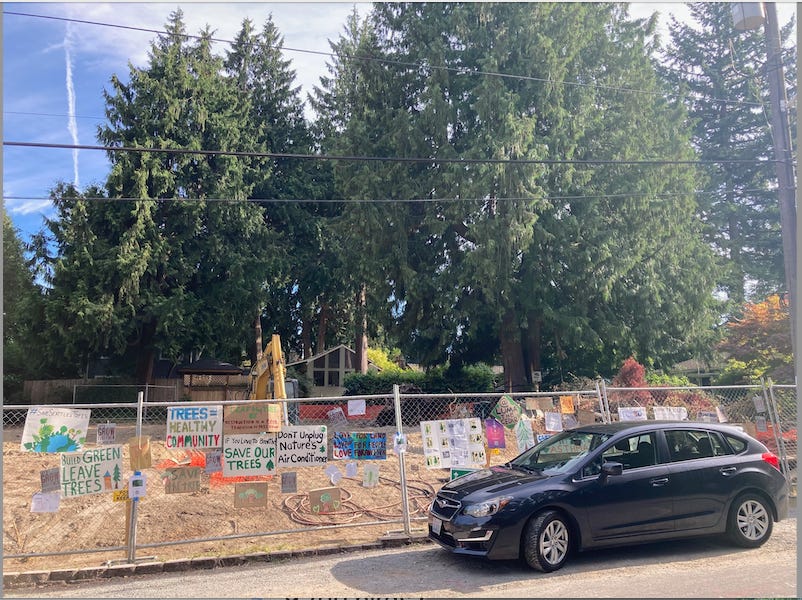To the Indigenous people of the Pacific Northwest, western red cedars have long been the tree of life. Ropes, cradles, and canoes. Homes, hats, baskets, and masks. Bowls and diapers. No object was too commonplace or too grand to be made from these beautiful trees. Now, one western red cedar has become central to the more recent inhabitants of Seattle. The double trunked tree grows in the Wedgwood neighborhood and has been slated to be cut down in order to build new homes.
As I have written before, my backyard is graced with three massive Douglas firs, so I know the passion one can develop for trees. Such trees are more than simply beautiful specimens of nature, harbors of habitat, and critically important in creating cleaner and healthier air, they are also beacons of memory, having watched over the many changes that occur in a community. When we cut one down, we sever many links that have helped bind together this place we call Seattle.
Let’s say that the Wedgwood cedar is a 150 years old. The species can live for up to 1,500 years so this one is a just a youngster. Consider what has transpired in the tree’s life. In its youth, the tree’s terminal growth stem was cut or broken, which caused two new stems to become dominant and grow. The memory of who cut the stem—perhaps a hungry deer—or of the event that broke it—possibly Seattle’s biggest snow storm, a massive 1916 dumper of more than three feet—will now be erased.
The Wedgwood cedar is old enough that when it began to grow, our very atmosphere was vastly different. The amount of carbon dioxide was about 288 ppm and the planet was emerging from the Little Ice Age. By the time the tree was sixty, the CO2 level was still around 300 ppm but then in the 1960s the level began to rise steeply: 320 to 350 to 390 to its present 420. Few other forms of life (one being geoducks) beyond a tree such as this cedar bear testimony to that pre-industrial era, when the air was sweet and clean.
We will also lose a memory of the Native people who have inhabited this landscape since time immemorial. Just north of the cedar at Thornton Creek was a fishing weir where people could have harvested salmon. Did they walk by this tree? A known trail ran between Lake Washington and a bog at what is now Northgate (called Slo'q'qed, or "bald head") so the first residents certainly traveled nearby. In addition, the Wedgwood cedar has been culturally modified, according to Jaime Martin of the Snoqualmie Tribe. Traditionally, modifications might include bending a branch to mark a trail or direction or stripping part of the bark for cultural uses, each an action preserved in the memory of the cedar.
More recently, the Wedgwood cedar has witnessed newer arrivals. One was a fellow member of my book club. In 1957, Stan and Marion Gartler built a house a few blocks from the Wedgwood cedar. He worked at the UW and did seminal research in somatic cell genetics, including an understanding of HeLa cells, made famous in The Immortal Life of Henrietta Lacks. Lives such as Stan’s and Marion’s have taken place all around the Wedgwood cedar and its loss will eliminate the imprints of those generations of families found within the cells of the tree.
When the Wedgwood cedar started life, the tree was surrounded by forest, most likely other western red cedars, along with western hemlocks and Douglas firs. Cedars often prefer slightly wetter spots than hemlock and fir so perhaps the little sprout started near a long lost seep, a location that could have attracted other wildlife, later generations of whom could have made a home in the cedar. Over its lifetime, the tree has been visited by countless animals and shared its space with wildflowers, fungi, shrubs, bacteria, and other trees. It has been a home, a refuge, and more recently a source of inspiration.
For some reason it survived as its neighbors succumbed to development. That legacy is a true treasure, a testimony to change and luck and serendipity, and to memory. If we cut down the Wedgwood cedar, not only do we lose a beautiful and valuable part of the community, both the human and more-than-human, but we also kill the stories of place and the memories that help bring us together.
Here’s a link to action you can take.
Other stuff of interest.
Best title for a newsletter I have seen recently. And, it’s a good read. “Let’s Talk about Anal Combs.” You’ll never think the same about frass again.
Photo of a cool thing I recently saw. Tree: 1 Rock: 0
These are flattened roots, which had grown down a crack in a rock but then must have pushed the rock aside. Although the roots have been cut, the tree is still doing well.





I often think how my 2 legacy Doug Firs have witnessed the original inhabitants of my 1919 home and property and other history. I stand back and admire their massive trunks and am grateful for their shade and homes they provide for birds and animals. With a total of 8 mature trees and 7 medium trees on a 9,000 square foot lot I have the most trees of anyone in the area.
You have led me to re-examine an other of my legacy trees, a Cedar with a 12’ trunk. I may have to find an expert to tell me more about its arm like branches.
*I do think that if the city wants more canopy there could be a fund to help remove an old tree when it dies. Some people are afraid to let them grow for fear of removal cost.
Thanks David! This was just on my mind, will be on my next issue :)